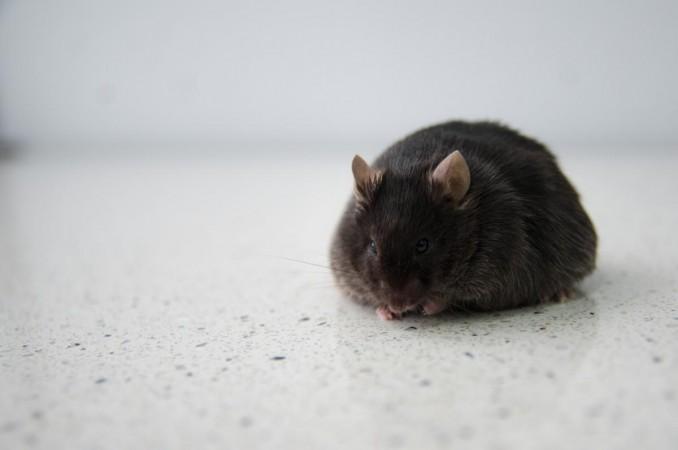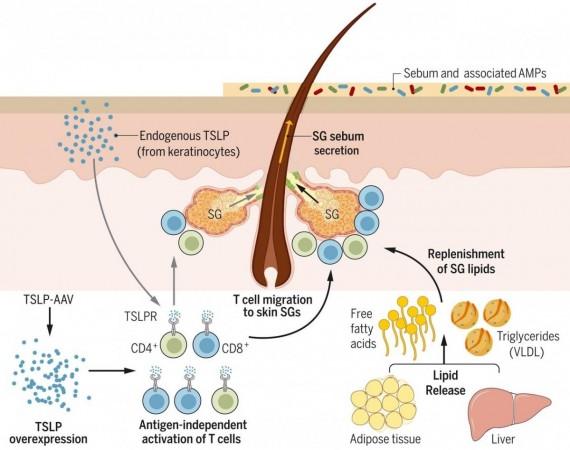Over the past few decades, obesity has emerged as a global health problem. It brings with it several risks that are life-threatening and can make existing illnesses worse. Therefore, enabling obese individuals to lose weight can save lives across the world. However, it is a challenging task. Now, scientists have accidentally stumbled upon a cytokine-induced mechanism that leads to weight loss by "sweating" fat through the skin.
According to the study, a cytokine known as thymic stromal lymphopoietin (TSLP) led to considerable loss of abdominal fat in an animal model. The authors were testing the effect of TSLP on diabetes in obese mice when they discovered that the cytokine triggered the immune system to release lipids through the sebaceous glands in the skin. Essentially, the mice "sweat" fat through their skins. The fat loss was not associated with faster metabolism or decreased food intake.
"This was a completely unforeseen finding, but we've demonstrated that fat loss can be achieved by secreting calories from the skin in the form of energy-rich sebum. We believe that we are the first group to show a non-hormonal way to induce this process, highlighting an unexpected role for the body's immune system," said Dr. Taku Kambayashi, principal investigator of the study, in a statement.
Treating Obese Mice With Cytokine

According to WHO, approximately 1.9 billion people across the world are overweight, with 650 million being obese. Around 4 million people die globally due to being overweight or obese. Obesity increases the risk of or leads to other ailments such as high blood pressure (hypertension), cardiovascular diseases (CVD), osteoarthritis, and type 2 diabetes, among others. Cytokines are signaling molecules that draw immune cells to the site of an infection. TSLP is one such cytokine that is associated with asthma and other allergic diseases.
The team has been evaluating the role of TSLP in activating Type 2 immune cells and increase regulatory T cells (Tregs) Older studies have suggested that these cells can moderate energy metabolism. Therefore, the researchers speculated that if overweight mice were treated with TSLP, the cytokine may trigger an immune response. This eventually may counter some of the detrimental effects of obesity. Thus, the scientists tested how TSLP affected Type 2 diabetes.
For this, obese mice were injected with a viral vector in order to increase the levels of TSLP in their bodies. Interestingly, after four weeks into the experiment, it was found that not only did TSLP have an effect on diabetes risk but it also reversed obesity in mice that had been fed a fat-dense diet. As the mice in the control group continued to put on weight, TSLP-treated mice lost weight and reached a healthy 25 grams from 45 grams, on average. Amazingly, it occurred in just 28 days.
Significant Weight Loss

Prominently, there was a decrease in the visceral fat mass in TSLP-treated mice. Visceral fat, also known as intra-abdominal fat, is the white-colored fat that is stored in the abdominal region around vital organs. It compounds the risk of stroke, diabetes, and heart disease. Additionally, the mice exhibited better fasting insulin and blood glucose levels, and a reduced risk of fatty liver disease (nonalcoholic steatohepatitis).
Based on such drastic changes, the authors presumed that TSLP was making the mice sick and resulting in decreased appetites. Surprisingly, additional testing revealed that animals in the TSLP-treated group were in fact consuming 20 to 30 percent more food. They spent similar amounts of energy, and their metabolic rates and activity levels were alike, in comparison to the control group.
"Initially, we did not think TSLP would have any effect on obesity itself. What we wanted to find out was whether it could impact insulin resistance. We thought that the cytokine could correct Type 2 diabetes, without actually causing the mice to lose any weight," stated Dr. Kambayashi.
"Sweating" Fat Away

While the team was amazed by the findings, it had overlooked a visible oddity. "When I looked at the coats of the TSLP-treated mice, I noticed that they glistened in the light. I always knew exactly which mice had been treated, because they were so much shinier than the others," noted Dr. Kambayashi. This is when an unlikely explanation was considered—Was the greasy coat of the mice an indication of them actually "sweating'" fat through their skin?
The researchers put their theory to test by shaving the control and TSLP-treated mice. They obtained oils from the fur. Dr. Kambayashi's initially improbable hypothesis indeed turned out to be true. Sebum-specific lipids were contained in the fur. Sebum is a calorie-rich oily or waxy substance manufactured by the sebaceous glands, particularly highly specialized epithelial cells called sebocytes in them. It coats, moisturizes, and protects the skin. This finding established that the TSLP-induced fat loss was on account of the release of oil via the skin.
Potential for Human Application?

In order to ascertain whether the cytokine could play a potential role in controlling oil secretions in human beings, the team evaluated TSLP and an array of 18 sebaceous gland-associated genes in a dataset that was publicly available. They learnt that the expression of TSLP was positively and considerably correlated with the expression of the sebaceous gland gene in healthy human skins.
According to the authors of the study, fat loss can be achieved in human beings by promoting "hypersecretion" of sebum. This may potentially result in the "sweating of fat" and loss of weight. The scientists intend to carry out further studies to continue testing their exciting hypothesis.
Talking about prospective human applications, Dr. Kambayashi expressed: "I don't think we naturally control our weight by regulating sebum production, but we may be able to highjack the process and increase sebum production to cause fat loss. This could lead to novel therapeutic interventions that reverse obesity and lipid disorders."









!['Had denied Housefull franchise as they wanted me to wear a bikini': Tia Bajpai on turning down bold scripts [Exclusive]](https://data1.ibtimes.co.in/en/full/806605/had-denied-housefull-franchise-they-wanted-me-wear-bikini-tia-bajpai-turning-down-bold.png?w=220&h=138)



